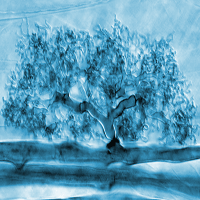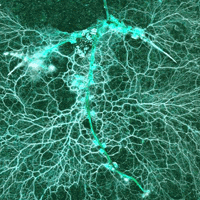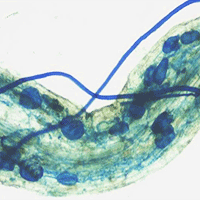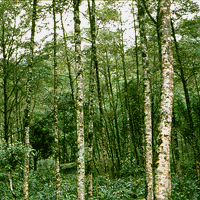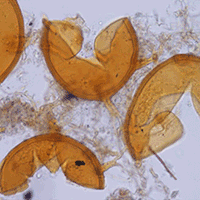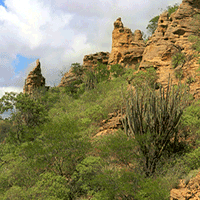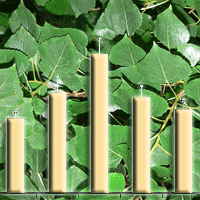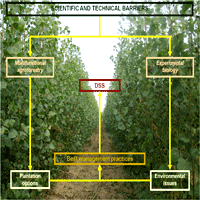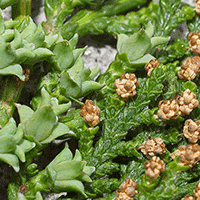Poplar is a suitable species for phytoremediation, able to tolerate high concentrations of heavy metals (HMs). Arbuscular mycorrhizal fungi (AMF) form symbiotic associations with the roots of most land plants; they improve nutrient uptake and enhance phytoextraction of HMs while alleviating stress in the host plant. This review summarizes previous results from field and greenhouse studies conducted by us and dealing with this topic. In a field trial on a highly Zn- and Cu-contaminated site, differences in plant survival and growth were observed among 168 clones originating from natural populations of Populus alba L. and Populus nigra L. from northern Italy. After two and a half years from planting, the density, activity and metabolic versatility of the culturable fraction of the soil bacteria in the HM-polluted field was higher in the soil close to where larger poplar plants were growing, in spite of comparable HM concentrations recorded in these soils. One well-performing clone of P. alba (AL35), which accumulated a higher concentration of both metals and had high foliar polyamine (PA) levels, was used for further investigation. In a greenhouse study, AL35 cuttings pre-inoculated with AMF (Glomus mosseae or Glomus intraradices) and then transferred to pots containing soil, collected from the HM-polluted site, displayed growth comparable to that of controls grown on unpolluted soil, in spite of higher Cu and Zn accumulation. Such plants also showed an overall up-regulation of metallothionein (MT) and PA biosynthetic genes, together with increased PA levels. A genome-wide transcriptomic (cDNA-AFLP) analysis allowed the identification of a number of genes, mostly belonging to stress-related functional categories of defense and secondary metabolism, that were differentially regulated in mycorrhizal vs. non mycorrhizal plants. A proteomic analysis revealed that, depending on sampling time, changes in protein profiles were differentially affected by AMF and/or HMs. It is concluded that soil-borne microorganisms affect plant performance on HM-polluted soil. In particular, mycorrhizal plants exhibited increased capacity for phytostabilization of HMs, together with improved growth. Their greater stress tolerance may derive from the protective role of PAs, and from the strong modulation in the expression profiles of stress-related genes and proteins.
Keywords
, , , , , , ,
Citation
Cicatelli A, Torrigiani P, Todeschini V, Biondi S, Castiglione S, Lingua G (2014). Arbuscular mycorrhizal fungi as a tool to ameliorate the phytoremediation potential of poplar: biochemical and molecular aspects. iForest 7: 333-341. - doi: 10.3832/ifor1045-007
Academic Editor
Alberto Santini
Paper history
Received: May 28, 2013
Accepted: Dec 31, 2013
First online: Apr 17, 2014
Publication Date: Oct 01, 2014
Publication Time: 3.57 months
© SISEF - The Italian Society of Silviculture and Forest Ecology 2014
Open Access
This article is distributed under the terms of the Creative Commons Attribution-Non Commercial 4.0 International (https://creativecommons.org/licenses/by-nc/4.0/), which permits unrestricted use, distribution, and reproduction in any medium, provided you give appropriate credit to the original author(s) and the source, provide a link to the Creative Commons license, and indicate if changes were made.

Breakdown by View Type
(Waiting for server response...)
Article Usage
Total Article Views: 57338
(from publication date up to now)
Breakdown by View Type
HTML Page Views: 46636
Abstract Page Views: 4275
PDF Downloads: 4968
Citation/Reference Downloads: 25
XML Downloads: 1434
Web Metrics
Days since publication: 4261
Overall contacts: 57338
Avg. contacts per week: 94.20
Article Citations
Article citations are based on data periodically collected from the Clarivate Web of Science web site
(last update: Mar 2025)
Total number of cites (since 2014): 27
Average cites per year: 2.25
Publication Metrics
by Dimensions ©
Articles citing this article
List of the papers citing this article based on CrossRef Cited-by.
(1)
Abou-Shanab R, Ghanem K, Ghanem N, Al Kolaibe A (2008)The role of bacteria on heavy-metal extraction and uptake by plants growing on multi-metal-contaminated soils. World Journal of Microbiology and Biotechnology 24: 253-262.
CrossRef |
Gscholar
(2)
Akashi K, Nishimura N, Ishida Y, Yokota A (2004)Potent hydroxyl radical-scavenging activity of drought-induced type-2 metallothionein in wild watermelon. Biochemical and Biophysical Research Communications 323: 72-78.
CrossRef |
Gscholar
(3)
Alcazar R, Altabella T, Marco F, Bortolotti C, Reymond M, Koncz C, Carrasco P, Tiburcio AF (2010)Polyamines: molecules with regulatory functions in plant abiotic stress tolerance. Planta 231: 1237-1249.
CrossRef |
Gscholar
(4)
Ali NA, Bernal MP, Ater M (2004)Tolerance and bioaccumulation of cadmium by
Phragmites australis grown in the presence of elevated concentrations of cadmium, copper, and zinc. Aquatic Botany 80: 163-176.
CrossRef |
Gscholar
(5)
Aloui A, Recorbet G, Robert F, Schoefs B, Bertrand M, Henry C, Gianinazzi-Pearson V, Dumas-Gaudot E, Aschi-Smit S (2011)Arbuscular mycorrhizal symbiosis elicits shoot proteome changes that are modified during cadmium stress alleviation in
Medicago truncatula. BMC Plant Biology 11: 75-82.
CrossRef |
Gscholar
(6)
Aravanopoulos FA, Kim KH, Zsuffa L (1999)Genetic diversity of superior
Salix clones selected for intensive forestry plantations. Biomass and Bioenergy 16: 249-255.
CrossRef |
Gscholar
(7)
Aronsson P, Perttu K (2001)Willow vegetation filters for wastewater treatment and soil remediation combined with biomass production. Forestry Chronicle 77: 293-299.
CrossRef |
Gscholar
(8)
Bagni N, Torrigiani P (1992)Polyamines: a new class of growth substances. In: “Progress in plant growth regulation” (Karseen CM, van Loon LC, Vreugdenhil D eds). Kluwer Academic Publishers, Dordrecht, The Netherlands, pp. 264-275.
CrossRef |
Gscholar
(9)
Balestrazzi A, Botti S, Zelasco S, Biondi S, Franchin C, Calligari P, Racchi M, Turchi A, Lingua G, Berta G, Carbonera D (2009)Expression of the PsMT (A1) gene in white poplar engineered with the MAT system is associated with heavy metal tolerance and protection against 8-hydroxy-2’-deoxyguanosine mediated-DNA damage. Plant Cell Reports 28: 1179-1192.
CrossRef |
Gscholar
(10)
Belimov AA, Safronova VI, Sergeyeva TA, Egorova TN, Matveyeva VA, Tsyganov VE, Borisov AY, Tikhonovich IA, Kluge C, Preisfeld A, Dietz KJ, Stepanok VV (2001)Characterization of plant growth promoting rhizobacteria isolated from polluted soils and containing 1-aminocyclopropane-1-carboxylate deaminase. Canadian Journal of Microbiology 47: 642-652.
CrossRef |
Gscholar
(11)
Bois G, Piche Y, Fung MYP, Khasa DP (2005)Mycorrhizal inoculum potentials of pure reclamation materials and revegetated tailing sands from the Canadian oil sand industry. Mycorrhiza 15: 149-158.
CrossRef |
Gscholar
(12)
Borghi M, Tognetti R, Monteforti G, Sebastiani L (2007)Responses of
Populus x euramericana (P. deltoides x P. nigra) clone Adda to increasing copper concentrations. Environmental and Experimental Botany 61: 66-73.
CrossRef |
Gscholar
(13)
Castiglione S, Cicatelli A, Lupi R, Patrignani G, Fossati T, Brundu G, Sabatti M, van Loo M, Lexer C (2010)Genetic structure and introgression in riparian populations of
Populus alba L. Plant Biosystems 144: 656-668.
CrossRef |
Gscholar
(14)
Castiglione S, Todeschini V, Franchin C, Torrigiani P, Gastaldi D, Cicatelli A, Rinaudo C, Berta G, Biondi S, Lingua G (2009)Clonal differences in survival capacity, copper and zinc accumulation, and correlation with leaf polyamine levels in poplar: a large-scale field trial on heavily polluted soil. Environmental Pollution 157: 2108-2117.
CrossRef |
Gscholar
(15)
Castiglione S, Franchin C, Fossati T, Lingua G, Torrigiani P, Biondi S (2007)High zinc concentrations reduce rooting capacity and alter metallothionein gene expression in white poplar (
Populus alba L. cv. Villafranca). Chemosphere 67: 1117-1126.
CrossRef |
Gscholar
(16)
Christophersen HM, Smith FA, Smith SE (2012)Unraveling the influence of arbuscular mycorrhizal colonization on arsenic tolerance in
Medicago:
Glomus mosseae is more effective than
G. intraradices, associated with lower expression of root epidermal Pi transporter genes. Frontiers in Physiology 3: 91.
CrossRef |
Gscholar
(17)
Cicatelli A, Todeschini V, Lingua G, Biondi S, Torrigiani P, Castiglione S (2014)Epigenetic control of heavy metal stress response in mycorrhizal versus non-mycorrhizal poplar plants. Environmental Science and Pollution Research 21: 1723-1737.
CrossRef |
Gscholar
(18)
Cicatelli A, Lingua G, Todeschini V, Biondi S, Torrigiani P, Castiglione S (2010)Arbuscular mycorrhizal fungi restore normal growth in a white poplar clone grown on heavy metal-contaminated soil, and this is associated with upregulation of foliar metallothionein and polyamine biosynthetic gene expression. Annals of Botany 106: 791-802.
CrossRef |
Gscholar
(19)
Cicatelli A, Lingua G, Todeschini V, Biondi S, Torrigiani P, Castiglione S (2012)Arbuscular mycorrhizal fungi modulate the leaf transcriptome of a
Populus alba L. clone grown on a zinc and copper-contaminated soil. Environmental and Experimental Botany 75: 25-35.
CrossRef |
Gscholar
(20)
Clijsters H, Cuypers A, Vangronsveld J (1999)Physiological responses to heavy metals in higher plants: defence against oxidative stress. Zeitschrift fur Naturforschung C-A Journal of Biosciences 54: 730-734.
Gscholar
(21)
Cobbett C, Goldsbrough P (2002)Phytochelatins and metallothioneins: roles in heavy metal detoxification and homeostasis. Annual Review of Plant Biology 53: 159-182.
CrossRef |
Gscholar
(22)
Copetta A, Lingua G, Berta G (2006)Effects of three AM fungi on growth, distribution of glandular hairs, and essential oil production in
Ocimum basilicum L. var. Genovese. Mycorrhiza 16: 485-494.
CrossRef |
Gscholar
(23)
Dabrowska G, Hrynkiewicz K, Trejgell A (2012)Do arbuscular mycorrhizal fungi affect metallothionein Mt2 expression in
Brassica napus L. roots? Acta Biologica Cracoviensia Series Botanica 54: 34-39.
Gscholar
(24)
Di Baccio D, Galla G, Bracci T, Andreucci A, Barcaccia G, Tognetti R, Sebastiani L (2011)Transcriptome analyses of
Populus x euramericana clone I-214 leaves exposed to excess zinc. Tree Physiology 31: 1293-1308.
CrossRef |
Gscholar
(25)
Dickinson NM, Pulford ID (2005)Cadmium phytoextraction using short-rotation coppice Salix: the evidence trail. Environment International 31: 609-613.
CrossRef |
Gscholar
(26)
Dos Santos Utmazian MN, Wenzel WW (2007)Cadmium and zinc accumulation in willow and poplar species grown on polluted soils. Journal of Plant Nutrition and Soil Science 170: 265-272.
CrossRef |
Gscholar
(27)
Dos Santos Utmazian MN, Wieshammer G, Vega R, Wenzel WW (2007)Hydroponic screening for metal resistance and accumulation of cadmium and zinc in twenty clones of willows and poplars. Environmental Pollution 148: 155-165.
CrossRef |
Gscholar
(28)
Doty SL (2008)Enhancing phytoremediation through the use of transgenics and endophytes. New Phytologist 179: 318-333.
CrossRef |
Gscholar
(29)
Edreva A, Velikova V, Tsonev T (2007)Phenylamides in plants. Russian Journal of Plant Physiology 54: 287-301.
CrossRef |
Gscholar
(30)
Fossati T, Patrignani G, Zapelli I, Sabatti M, Sala F, Castiglione S (2004)Development of molecular markers to assess the level of introgression of
Populus tremula into
P. alba natural populations. Plant Breeding 123: 382-385.
CrossRef |
Gscholar
(31)
Franchin C, Fossati T, Pasquini E, Lingua G, Castiglione S, Torrigiani P, Biondi S (2007)High concentrations of zinc and copper induce differential polyamine responses in micropropagated white poplar (
Populus alba). Physiologia Plantarum 130: 77-90.
CrossRef |
Gscholar
(32)
Frey B, Ruedt A, Widmer F (2010)Changes in rhizosphere bacterial populations during phytoextraction of heavy metal contaminated soil with poplar. Plant Biosystems 144: 392-395.
CrossRef |
Gscholar
(33)
Gamalero E, Cesaro P, Cicatelli A, Todeschini V, Musso C, Castiglione S, Fabiani A, Lingua G (2012)Poplar clones of different sizes, grown on a heavy metal polluted site, are associated with microbial populations of varying composition. Science of the Total Environment 425: 262-270.
CrossRef |
Gscholar
(34)
Gamalero E, Lingua G, Berta G, Glick BR (2009)Beneficial role of plant growth promoting bacteria and arbuscular mycorrhizal fungi on plant responses to heavy metal stress. Canadian Journal of Microbiology 55: 501-514.
CrossRef |
Gscholar
(35)
Gohre V, Paszkowski U (2006)Contribution of the arbuscular mycorrhizal symbiosis to heavy metal phytoremediation. Planta 223: 1115-1122.
CrossRef |
Gscholar
(36)
Groppa M, Benavides M (2008)Polyamines and abiotic stress: recent advances. Amino Acids 34: 35-45.
CrossRef |
Gscholar
(37)
Groppa MD, Tomaro ML, Benavides MP (2007)Polyamines and heavy metal stress: the antioxidant behavior of spermine in cadmium- and copper-treated wheat leaves. Biometals 20: 185-195.
CrossRef |
Gscholar
(38)
Guerrieri E, Lingua G, Digilio MC, Massa N, Berta G (2004)Do interactions between plant roots and the rhizosphere affect parasitoid behaviour? Ecological Entomology 29: 753-756.
CrossRef |
Gscholar
(39)
Hanfrey C, Franceschetti M, Mayer MJ, Illingworth C, Michael AJ (2002)Abrogation of upstream open reading frame-mediated translational control of a plant S-adenosylmethionine decarboxylase results in polyamine disruption and growth perturbations. Journal of Biological Chemistry 277: 44131-44139.
CrossRef |
Gscholar
(40)
Hartmann A, Lemanceau P, Prosser JI (2008)Multitrophic interactions in the rhizosphere - rhizosphere microbiology: at the interface of many disciplines and expertises. Fems Microbiology Ecology 65: 179.
CrossRef |
Gscholar
(41)
Hassinen V, Vallinkoski VM, Issakainen S, Tervahauta A, Karenlampi S, Servomaa K (2009)Correlation of foliar MT2b expression with Cd and Zn concentrations in hybrid aspen (
Populus tremula x tremuloides) grown in contaminated soil. Environmental Pollution 157: 922-930.
CrossRef |
Gscholar
(42)
He CQ, Tan G, Liang X, Du W, Chen Y, Zhi G, Zhu Y (2010)Effect of Zn-tolerant bacterial strains on growth and Zn accumulation in
Orychophragmus violaceus. Applied Soil Ecology 44: 1-5.
CrossRef |
Gscholar
(43)
Hohnjec N, Vieweg ME, Puhler A, Becker A, Kuster H (2005)Overlaps in the transcriptional profiles of
Medicago truncatula roots inoculated with two different
Glomus fungi provide insights into the genetic program activated during arbuscular mycorrhiza. Plant Physiology 137: 1283-1301.
CrossRef |
Gscholar
(44)
Hua J, Lin X, Bai J, Shao Y, Yin R, Jiang Q (2010)Effects of arbuscular mycorrhizal fungi and earthworm on nematode communities and arsenic uptake by maize in arsenic-contaminated soils. Pedosphere 20: 163-173.
CrossRef |
Gscholar
(45)
Kohler A, Blaudez D, Chalot M, Martin F (2004)Cloning and expression of multiple metallothioneins from hybrid poplar. New Phytologist 164: 83-93.
CrossRef |
Gscholar
(46)
Kopponen P, Utriainen M, Lukkari K, Suntioinen S, Karenlampi L, Karenlampi S (2001)Clonal differences in copper and zinc tolerance of birch in metal-supplemented soils. Environmental Pollution 112: 89-97.
CrossRef |
Gscholar
(47)
Kuffner M, Puschenreiter M, Wieshammer G, Gorfer M, Sessitsch A (2008)Rhizosphere bacteria affect growth and metal uptake of heavy metal accumulating willows. Plant and Soil 304: 35-44.
CrossRef |
Gscholar
(48)
Kusano T, Berberich T, Tateda C, Takahashi Y (2008)Polyamines: essential factors for growth and survival. Planta 228: 367-381.
CrossRef |
Gscholar
(49)
Kuthanova A, Gemperlova L, Zelenkova S, Eder J, Machackova I, Opatrny Z, Cvikrova M (2004)Cytological changes and alterations in polyamine contents induced by cadmium in tobacco BY-2 cells. Plant Physiology and Biochemistry 42: 149-156.
CrossRef |
Gscholar
(50)
Laureysens I, Blust R, De Temmerman L, Lemmens C, Ceulemans R (2004)Clonal variation in heavy metal accumulation and biomass production in a poplar coppice culture. I. Seasonal variation in leaf, wood and bark concentrations. Environmental Pollution 131: 485-494.
CrossRef |
Gscholar
(51)
Lebeau T, Braud A, Jezequel K (2008)Performance of bioaugmentation-assisted phytoextraction applied to metal contaminated soils: a review. Environmental Pollution 153: 497-522.
CrossRef |
Gscholar
(52)
Lei Y, Korpelainen H, Li C (2007)Physiological and biochemical responses to high Mn concentrations in two contrasting
Populus cathayana populations. Chemosphere 68: 686-694.
CrossRef |
Gscholar
(53)
Lingua G, D’Agostino G, Massa N, Antosiano M, Berta G (2002)Mycorrhiza-induced differential response to a yellows disease in tomato. Mycorrhiza 12: 191-198.
CrossRef |
Gscholar
(54)
Lingua G, Bona E, Todeschini V, Cattaneo C, Marsano F, Berta G, Cavaletto M (2012)Effects of heavy metals and arbuscular mycorrhiza on the leaf proteome of a selected poplar clone: a time course analysis. Plos One 7 (6): e38662.
CrossRef |
Gscholar
(55)
Lingua G, Franchin C, Todeschini V, Castiglione S, Biondi S, Burlando B, Parravicini V, Torrigiani P, Berta G (2008)Arbuscular mycorrhizal fungi differentially affect the response to high zinc concentrations of two registered poplar clones. Environmental Pollution 153: 137-147.
CrossRef |
Gscholar
(56)
Liu J, Wu L, Wei S, Xiao X, Su C, Jiang P, Song Z, Wang T, Yu Z (2007)Effects of arbuscular mycorrhizal fungi on the growth, nutrient uptake and glycyrrhizin production of licorice (
Glycyrrhiza uralensis Fisch). Plant Growth Regulation 52: 29-39.
CrossRef |
Gscholar
(57)
Lovaas E (1997)Antioxidative and metal-chelating effects of polyamines. Advances in Pharmacology 38: 119-149.
CrossRef |
Gscholar
(58)
Martin Tanguy J (1997)Conjugated polyamines and reproductive development: biochemical, molecular and physiological approaches. Physiologia Plantarum 100: 675-688.
CrossRef |
Gscholar
(59)
Mrnka L, Kuchar M, Cieslarova Z, Matejka P, Szakova J, Tlustos P, Vosatka M (2012)Effects of endo- and ectomycorrhizal fungi on physiological parameters and heavy metals accumulation of two species from the family Salicaceae. Water Air and Soil Pollution 223: 399-410.
CrossRef |
Gscholar
(60)
Ouziad F, Hildebrandt U, Schmelzer E, Bothe H (2005)Differential gene expressions in arbuscular mycorrhizal-colonized tomato grown under heavy metal stress. Journal of Plant Physiology 162: 634-649.
CrossRef |
Gscholar
(61)
Pallara G, Todeschini V, Lingua G, Camussi A, Racchi ML (2013)Transcript analysis of stress defence genes in a white poplar clone inoculated with the arbuscular mycorrhizal fungus
Glomus mosseae and grown on a polluted soil. Plant Physiology and Biochemistry 63: 131-139.
CrossRef |
Gscholar
(62)
Park MS, Jung SR, Lee KH, Lee MS, Do JO, Kim SB, Bae KS (2006)Chryseobacterium soldanellicola sp. nov. and
Chryseobacterium taeanense sp. nov., isolated from roots of sand-dune plants. International Journal of Systematic and Evolutionary Microbiology 56: 433-438.
CrossRef |
Gscholar
(63)
Pilon-Smits E (2005)Phytoremediation. Annual Review of Plant Biology 56: 15-39.
CrossRef |
Gscholar
(64)
Piotrowska-Seget Z, Cycon M, Kozdroj J (2005)Metal-tolerant bacteria occurring in heavily polluted soil and mine spoil. Applied Soil Ecology 28: 237-246.
CrossRef |
Gscholar
(65)
Prabhavathi V, Rajam MV (2007)Mannitol-accumulating transgenic eggplants exhibit enhanced resistance to fungal wilts. Plant Science 173: 50-54.
CrossRef |
Gscholar
(66)
Punshon T, Dickinson NM (1997)Acclimation of Salix to metal stress. New Phytologist 137: 303-314.
CrossRef |
Gscholar
(67)
Quoreshi A, Khasa D (2008)Effectiveness of mycorrhizal inoculation in the nursery on root colonization, growth, and nutrient uptake of aspen and balsam poplar. Biomass and Bioenergy 32: 381-391.
CrossRef |
Gscholar
(68)
Rajkumar M, Sandhya S, Prasad M, Freitas H (2012)Perspectives of plant-associated microbes in heavy metal phytoremediation. Biotechnology Advances 30: 1562-1574.
CrossRef |
Gscholar
(69)
Rivera-Becerril F, Metwally A, Martin-Laurent F, Van Tuinen D, Dietz KJ, Gianinazzi S, Gianinazzi-Pearson V (2005)Molecular responses to cadmium in roots of
Pisum sativum L. Water Air and Soil Pollution 168: 171-186.
CrossRef |
Gscholar
(70)
Rodriguez R, Redman R (2008)More than 400 million years of evolution and some plants still can’t make it on their own: plant stress tolerance via fungal symbiosis. Journal of Experimental Botany 59: 1109-1114.
CrossRef |
Gscholar
(71)
Sannazzaro AI, Echeverria M, Alberto EO, Ruiz OA, Menendez AB (2007)Modulation of polyamine balance in
Lotus glaber by salinity and arbuscular mycorrhiza. Plant Physiology and Biochemistry 45: 39-46.
CrossRef |
Gscholar
(72)
Schüßler A, Walker C (2010)The
Glomeromycota: a species list with new families and new genera. The Royal Botanic Garden Edinburgh, The Royal Botanic Garden Kew, Botanische Staatssammlung Munich, and Oregon State University, Gloucester, UK, pp. 56.
Online |
Gscholar
(73)
Sebastiani L, Scebba F, Tognetti R (2004)Heavy metal accumulation and growth responses in poplar clones Eridano (
Populus deltoides x maximowiczii) and I-214 (
P. x euramericana) exposed to industrial waste. Environmental and Experimental Botany 52: 79-88.
CrossRef |
Gscholar
(74)
Sharma SS, Dietz KJ (2006)The significance of amino acids and amino acid-derived molecules in plant responses and adaptation to heavy metal stress. Journal of Experimental Botany 57: 711-726.
CrossRef |
Gscholar
(75)
Shilev SI, Ruso J, Puig A, Benlloch M, Jorrin J, Sancho E (2001)Rhizospheric bacteria promote sunflower (
Helianthus annuus L.) plant growth and tolerance to heavy metals. Minerva Biotecnologica 13: 37-39.
Gscholar
(76)
Smith SE, Read DJ (1997)Mycorrhizal symbiosis (2nd edn). Academic Press, London, UK, pp. 605.
Gscholar
(77)
Smith SE, Facelli E, Pope S, Smith F (2010)Plant performance in stressful environments: interpreting new and established knowledge of the roles of arbuscular mycorrhizas. Plant and Soil 326: 3-20.
CrossRef |
Gscholar
(78)
Smulders M, Cottrell J, Lefevre F, van der Schoot J, Arens P, Vosman B, Tabbener H, Grassi F, Fossati T, Castiglione S, Krystufek V, Fluch S, Burg K, Vornam B, Pohl A, Gebhardt K, Alba N, Agundez D, Maestro C, Notivol E, Volosyanchuk R, Pospiskova M, Bordacs S, Bovenschen J, van Dam B, Koelewijn H, Halfmaerten D, Ivens B, van Slycken J, Broeck A, V, Storme V, Boerjan W (2008)Structure of the genetic diversity in black poplar (
Populus nigra L.) populations across European river systems: consequences for conservation and restoration. Forest Ecology and Management 255: 1388-1399.
CrossRef |
Gscholar
(79)
Solis-Dominguez FA, Valentin-Vargas A, Chorover J, Maier RM (2011)Effect of arbuscular mycorrhizal fungi on plant biomass and the rhizosphere microbial community structure of mesquite grown in acidic lead/zinc mine tailings. Science of the Total Environment 409: 1009-1016.
CrossRef |
Gscholar
(80)
Takacs D, Radimszky L, Nemeth T (2005)The arbuscular mycorrhizal status of poplar clones selected for phytoremediation of soils contaminated with heavy metals. Zeitschrift fur Naturforschung CA Journal of Biosciences 60: 357-361.
Online |
Gscholar
(81)
Thewys T, Witters N, Meers E, Vangronsveld J (2010)Economic viability of phytoremediation of a cadmium contaminated agricultural area using energy maize. Part II: economics of anaerobic digestion of metal contaminated maize in Belgium. International Journal of Phytoremediation 12: 663-679.
CrossRef |
Gscholar
(82)
Todeschini V, Franchin C, Castiglione S, Burlando B, Biondi S, Torrigiani P, Berta G, Lingua G (2007)Responses to copper of two registered poplar clones inoculated or not with arbuscular mycorrhizal fungi. Caryologia 60: 146-155.
CrossRef |
Gscholar
(83)
Tognetti R, Cocozza C, Marchetti M (2013)Shaping the multifunctional tree: the use of Salicaceae in environmental restoration. iForest 6: 37-47.
CrossRef |
Gscholar
(84)
Tsai CJ, Harding SA, Tschaplinski TJ, Lindroth RL, Yuan Y (2006)Genome-wide analysis of the structural genes regulating defense phenylpropanoid metabolism in
Populus. New Phytologist 172: 47-62.
CrossRef |
Gscholar
(85)
Tseng CC, Wang JY, Yang L (2009)Accumulation of copper, lead, and zinc by in situ plants inoculated with AM fungi in multicontaminated soil. Communications in Soil Science and Plant Analysis 40: 3367-3386.
CrossRef |
Gscholar
(86)
Tuskan GA, DiFazio SP, Teichmann T (2004)Poplar genomics is getting popular: the impact of the poplar genome project on tree research. Plant Biology 6: 2-4.
CrossRef |
Gscholar
(87)
van der Lelie D, Taghavi S, Monchy S, Schwender J, Miller L, Ferrieri R, Rogers A, Wu X, Zhu W, Weyens N, Vangronsveld J, Newman L (2009)Poplar and its bacterial endophytes: coexistence and harmony. Critical Reviews in Plant Sciences 28: 346-358.
CrossRef |
Gscholar
(88)
Velikova V, Yordanov I, Edreva A (2000)Oxidative stress and some antioxidant systems in acid rain-treated bean plants - protective role of exogenous polyamines. Plant Science 151: 59-66.
CrossRef |
Gscholar
(89)
Zalesny RS, Bauer EO, Hall RB, Zalesny JA, Kunzman J, Rog CJ, Riemenschneider DE (2005)Clonal variation in survival and growth of hybrid poplar and willow in an
in situ trial on soils heavily contaminated with petroleum hydrocarbons. International Journal of Phytoremediation 7: 177-197.
CrossRef |
Gscholar
